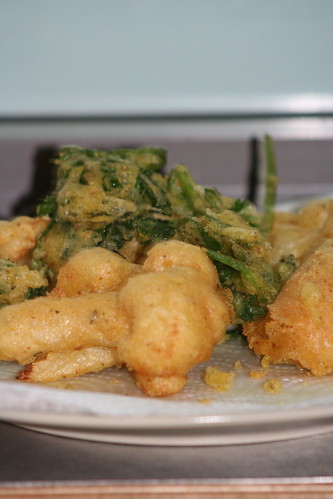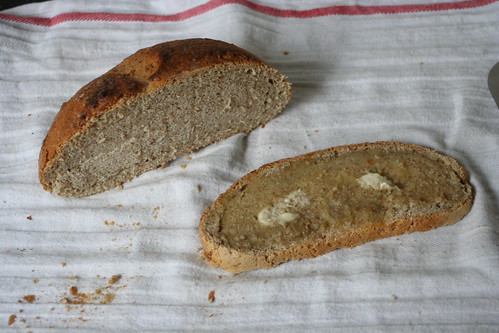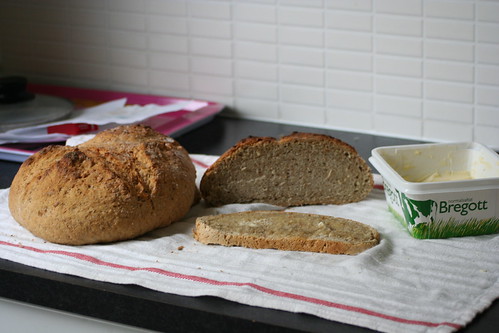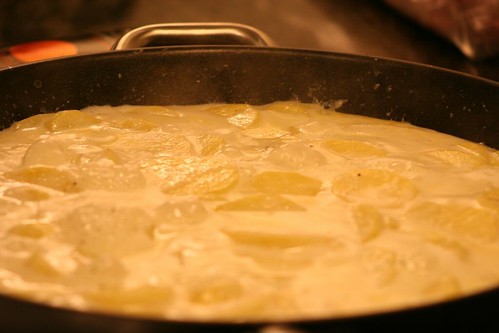Munich went from early autumn warmth to late autumn chill overnight, as it does. The Bavarians can't be bothered with four seasons, two are plenty--one where you sit outside in beer gardens at night and drink beer, and one where you huddle up with
Glühwein (mulled wine) or go skiing in the alps. They may be right, but for those of us who grew up in Stockholm, where any particular weather tends to linger long enough for you to get to know it by first name, it can be disconcerting to be able to see your breath just a day after you were out walking in a t-shirt and shorts.
When the cold season comes marching in, the thoughts of a foodie naturally turn to heartier fare: oven roast, potato gratin, anything with lots of cream and butter... As any ringed seal could tell you, the best way to fortify yourself before a cold winter is a decent fat layer, and so we enter Butter & Beans' territory. Of course, you'll also be needing your vitamins and minerals when the sun doesn't shine, so vegetables are essential.
The combination of vegetable and fat is a time honoured tradition in most countries. We've recently visited France for a
potato gratin, and today we're taking a look in the general direction of India, although the recipe is courtesy of a resident of the Indians' former colonial masters, namely Jamie Oliver. The recipe, deep fried cauliflower with spices, is from his
Jamie at Home series/book.
Like most people, I long ago realized the almost magic ability of deep frying to bring out the full delicious potential of food, and ever since, I've longed to be able to clog my arteries with my own creations. I've owned a few deep fryers since, but somehow the results were never really good. Then one day, this spring, I decided to try my hand at deep frying "by hand", with just a pot, some oil, and a little piece of bread as a temperature indicator.
And you know what? It finally clicked. I think it might partly be that my old fryers didn't really have the heat capacity to keep the oil hot enough, but mostly I think it's that I finally really focused on the process; looked at the oil, smelled it, placed my cauliflower in it by hand, looked at it as it changed colour, and extracted it piecewise with a slotted spoon. So, if like me, you've been somewhat challenged in this area of your cooking, try it once with just the pot!
Well, let's put our recipes where our mouth's are, shall we?
Deep fried cauliflowerInspired by Jamie Oliver.
1 cauliflower head
200 g self-raising flour, or 200 g flour + 10 g baking powder
1 bottle of beer
1-2 tsp salt
1-2 Tbsp spices, suggestions: turmeric, chili, pepper, caraway
oil for deep frying
lemon to serve
Pour oil into a large saucepot and put on high heat. Trim the leaves off your cauliflower, cut off the largest parts of the stem, then break down into small florets. Sprinkle the cauliflower with some flour, and set aside. Grind the spices with a mortar and pestle, combine with salt and flour in a bowl. Whisk in beer until the batter reaches the consistency of thick cream, then mix in the cauliflower pieces.
Check if the oil is hot with a thermometer (180 °C / 350 °F), or simply place a piece of bread or raw potato in the oil. When it surfaces and goes golden quickly, the oil is hot enough.
Place little batches of the cauliflower, piece by piece, into the oil--
drop them away from you! Fry for about 3-4 minutes, or until the batter's gone really golden and nice. Remove with a slotted spoon, let drip off a little on kitchen towels, then sprinkle with salt, and serve with some lemon to squeeze over.
If you want to, you can also dip some parsley branches in the batter and fry them for 30 seconds. A nice little garnish.

Oh, and don't take pictures of them with a flash, or they'll look nasty, like the fries that have been lying around all day in a 24/7 kebab place, and not crunchy and delicious, like these will be.













